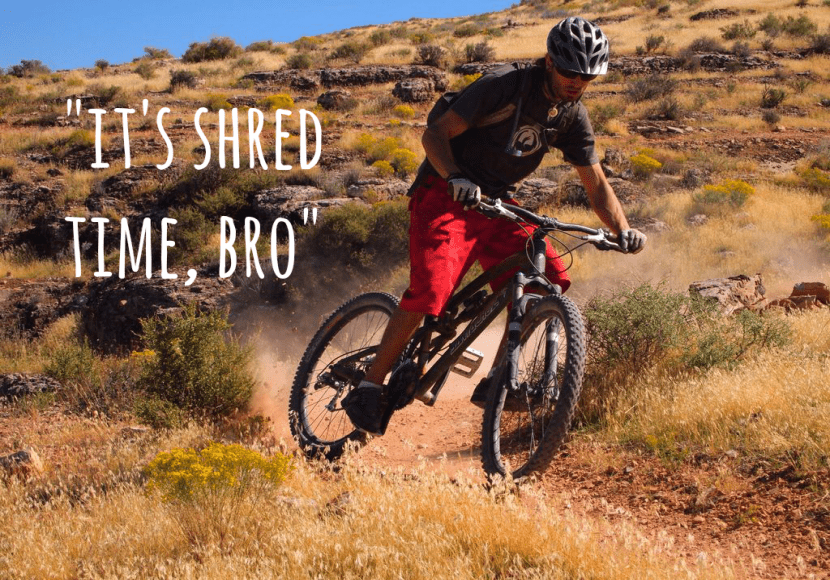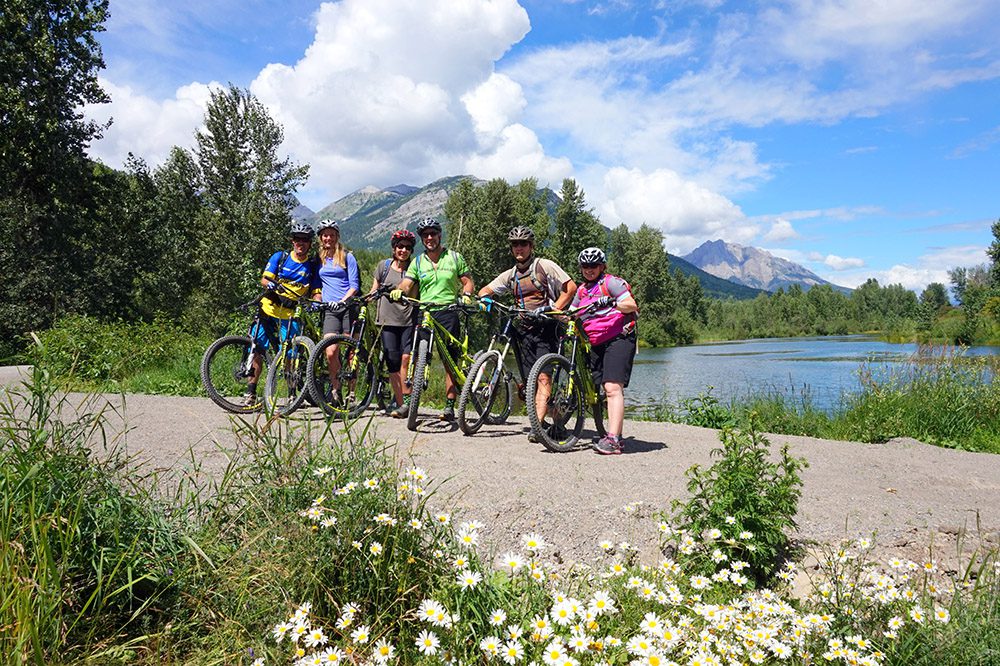August 23, 2014
(adapted from the ABC of Mountain Biking)

There are so many mountain bike terms and jargon out there that anyone new to the sport can easily feel like they’re joining a fraternity or becoming a pirate. It’s pretty easy to feel confused — I remember going on my first mountain bike ride at 15 and being asked by another rider how I was fairing with rigid forks. “Huh…I’m not carrying any form of cutlery” was my response. Yes friends, the learning curve was steep. Check out this list to learn the basics of mountain bike terminology. To be sure, it’s far from being a complete lexicon of all mountain bike lingo, but a quick overview of commonly used mountain biking terms any beginner may encounter when fraternizing with other mountain bikers.
ATTACK POSITION
the alert and well-balanced position you ride in when you approach, or ride on, rough terrain. It is characterized by bent knees, rear above the saddle, elbows slightly bent, and a raised head.
BERM
an embankment on a trail.
BONK
when you run out of energy.
BUNNY HOP
a hop that you incorporate into your riding technique so you can clear obstacles such as logs without stopping.
CHAIN SUCK
the dragging and jamming of your chain that occurs in sloppy conditions, or when little burs occur on your chainrings that cause the chain to bunch up. CLEANa perfect ride through a tough section.
CLIPLESS PEDAL
a pedal that has spring-loaded cleats that clip to a riders shoe.
CROSS-COUNTRY
a traditional mountain bike race that mixes many types of riding conditions into one coarse.
CYCLOCROSS
an off-road race that involves riders having to dismount and run over obstacles, carrying their bikes.
DIALED IN
when everything on your bike is running smoothly, you are said to be “dialed in”
DOUBLETRACK
two trails that run parallel to each other (also called tractor trail or Jeep trail).
DOWNHILL
a type of racing held mostly on ski slopes — fastest rider to the bottom wins.
DOWNSHIFT
shifting to a lower gear.
DROPPING IN
Dropping in a steep single track when other riders are around.
DUALIE
a bike that has both front and rear suspension.
ENDO
a crash that involves going over the handlebars of your bike.
ENDURO
a form of mountain bike racing in which there is a greater proportion of downhill sections, which are timed, to uphill and cross country sections.
FIRE ROAD
a back country dirt or gravel road wide enough for emergency vehicles to use.
FORK
the part of the bike that attaches the front wheel to the frame.
GNARL
extreme technical sections. Characterized by very rough, rooty, slippery, or rocky sections. Commonly found in the Pacific Northwest and New England. “He has got some great bike handling skills and can really scream through the gnarl.”
GRANNY GEAR
the lowest gear available on a bike, which only a grandmother would need to use; designed for steep uphill climbing, but extremely easy to pedal in on flat ground.
GRINDER
a long uphill climb.
GRUNT
a very difficult climb, requiring use of the granny gear.
HARDTAIL
a mountain bike that has no rear suspension.
IMBA
International Mountain Biking Association. An organization for trail advocacy.
INVOLUNTARY DISMOUNT
a crash.
KNOBBY TIRES
the all-terrain tires that are used on mountain bikes.
LID
helmet.
LINE
the desirable path or strategy to take on a tricky trail section.
MTB
Short for mountain bike.
MUD DIVING
what happens when a bike slows abruptly in mud, throwing the rider into wet goo.
NORBA
(National Off-Road Bicycle Association) — USA Cycling’s mountain bike racing division.
OFF-CAMBER
sloped ground that makes handling difficult.
PINCH FLAT
a tire flat that is caused when the tube is pinched against the rim internally.
PRESTA VALVE
the narrow valve found on most mountain bike inner tubes. A metal cap must be unscrewed before air can enter or exit.
PSI
the tire inflation measurement. It stands for pounds per square inch.
RATCHET
a riding technique in which you pedal in partial strokes in order to clear obstacles.
ROCK GARDEN
This refers to a section of trail covered with big rocks.
SCHRADER VALVE
the type of valve used on most cars and trucks. They are found on less expensive bicycle tubes and are spring-loaded to release air or let it in.
SHRED
negotiating trails with a higher-than-usual level of expertise.
SINGLETRACK
a narrow mountain bike trail that must be ridden single file.
SNAKEBITE
same as a pinch flat, but has two holes. (same causative mechanism)
STANDOVER CLEARANCE
the distance between the top tube and the rider’s crotch.
SWITCHBACK
a turn on a hill that is too steep to be climbed without zig-zagging.
THE ZONE
a state of mind experienced while riding. You don’t think, you just do. A truly mystical experience that can’t be fully explained, but when you get there you’ll know it and strive to reach it again.
TRACKSTAND
a riding technique that involves the rider stopping completely without putting a foot down.
TRAVEL
the distance a suspension fork or a shock can compress.
UPSHIFT
to shift into a higher gear.
WASH OUT
to have the front tire lose traction, especially while going around a corner.
WASHBOARD
small, regular undulations of the soil surface that make for a very rough ride.
WEIGHT-WEENIE
a MTB owner (not even necessarily a rider) who is more concerned with how many milligrams a certain component saves off the bike’s total weight than with how to be a better rider.
WHEELIE
lifting the front wheel off the ground, usually with some combination of pulling on the handlebars, pedaling harder, and balance.
WIPEOUT
a crash. v. (“wipe out”) to crash.
WONKY
not functioning properly. “I bailed, and now my wheel is all wonky and all I hear are wild pigs.”
XC
Short for “cross country” – see above.
YARD SALE
a horrendous crash that leaves all your various “wares” — water bottles, pump, tool bag, etc. — scattered as if on display for sale.

